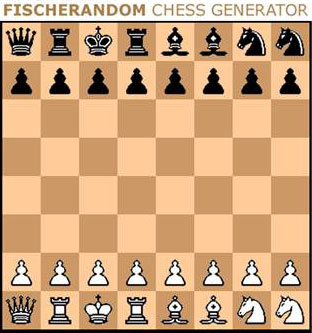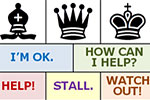Singapore’s 1st Chess960 and Transfer Chess Championships
By Leung Weiwen
Over the weekend of 2 and 3 February, Singapore held its 1st National Chess960
Championships and the 1st National Transfer Chess Championships (called Bughouse
in some countries). The Championships were co-organized by the Singapore Chess
Federation and the Mindsports Club of the Singapore Management University.

Starting position being determined by random number generator

The starting position of one of the most exciting rounds of Chess960
The Chess960 field was strong and included former National Champions Jason Goh
and Luke Leong. After nine grueling rounds, Jarred Neubronner, who is about
to complete his two year full-time national service stint, won the tournament.

Thinking hard in the Chess960 matches: FM Luke Leong is in a striped shirt
whilst
IM Jason Goh is wearing maroon. Jarred Neubronner is playing white on the next
board.

View from the Chess960 tournament hall – Singapore’s financial
district

The Transfer Chess Championship was held at the University’s library
Mention “transfer chess” or “bughouse” and one usually
thinks of a noisy club scene, where players discuss team strategy and what pieces
they need. For the uninitiated, transfer chess is played by teams of two players,
one taking white and the other black. Captured pieces may be passed to one’s
partner. The partner can then place it on the board. Such games tend to be noisy
because it’s very common for a player to tell his partner that he needs
a certain piece to carry out a mating attack.
Two members of tournament’s organizing committee, Cyril Chua and Chua
Wei Yuan, came up with a novel rule that reduced much of the noise of transfer
chess, thereby making it a more “civilized” game – but still
equally exciting.

The Transfer Communication Sheet is the cardboard between both chessboards,
each team had one TCS. The team facing the camera are Tin Jingyao and Lee Qing
Aun, who finished 3rd. Their opponents finished 2nd.
For this tournament, players were allowed to communicate only through a Transfer
Communication Sheet (TCS, see above picture). The TCS can be seen clearly in
the below picture.
The rules used for the Championships can be found in the link below. Cyril
Chua and Chua Wei Yuan intend to submit it to FIDE for approval as a Laws of
Chess Appendix, and they welcome comments.
The multisport Southeast Asian Games (SEA Games) will be held in Myanmar in
December 2013. Chess, Chess960 and Transfer Chess will be included alongside
other sports such as athletics and soccer. A total of 18 gold medals will be
up for grabs in the chess events. It looks like transfer chess has a very bright
future as a chess variant. With all the excitement it generates, I would not
be surprised if transfer chess becomes nearly as popular as blitz chess. I would
be shocked if transfer chess became the standard version of chess, but such
a scenario is not necessarily implausible. After all, a few hundred years ago,
pawns could only move one square at a time, and queens could only move diagonally.
Links

|
Links
- Other articles by Leung Weiwen
- See also
Leung Weiwen is a volunteer at the Singapore Chess Federation
and Mindsports Club of Singapore Management University. He supports
the popularization of both Chess960 and transfer chess – in particular,
transfer chess as it helps to build teamwork and forge friendships.
Other articles he has written for ChessBase include “Where a hundred
cultures met”, “A cure for Severe Acute Drawitis”,
and “Can population or GDP explain chess success?”
Copyright
Leung Weiwen/ChessBase |































